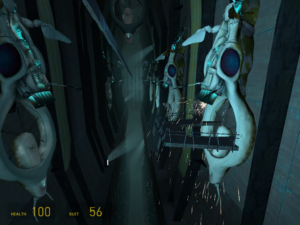Half-Life 2: Ending
 The original Half-Life memorably begins as a literal “game on rails”, with the player confined 1Actually, you can get out while the car is in motion if you really want to. You just die immediately. to a train car as it passes by various scenes you’ll encounter later in the game. It’s essentially a cross between a theme park ride and machinima.
The original Half-Life memorably begins as a literal “game on rails”, with the player confined 1Actually, you can get out while the car is in motion if you really want to. You just die immediately. to a train car as it passes by various scenes you’ll encounter later in the game. It’s essentially a cross between a theme park ride and machinima.
The equivalent scene in Half-Life 2 comes toward the end, when Gordon rides around the invaders’ cavernous citadel in a coffin-like restraint hanging from a network of rails, a device seen earlier hauling prisoners around. Where the Half-Life train was a vehicle of foreshadowing, this is one of recapitulation and recontextualization, as you’re shown the things you’ve been fighting against — the gunships and tripod robots and cyborgs (for that’s what the Combine soldiers are, as the player certainly suspects by this point) — as mass-produced components of a vast, inhuman war machine that Hitler could only dream of.
It would be daunting to stand alone against all this if it weren’t for the fact that you know the game is ending soon and all you really have to stand against is a final puzzle-boss. The game powers you up for the last few battles, doubling your maximum “energy” (armor) and granting you a last-minute Ulitmate Weapon, after destroying all your other weapons to make sure you use only the Ultimate one.
The crazy thing is that the Ultimate Weapon is a powered-up Gravity Gun. The Gravity Gun is one of three special-purpose weapons in the game, the other two being the Pheropod that controls the bugs, and the rocket launcher. (A rocket launcher may not sound like a special weapon — it’s part of the Doom-standard arsenal, after all — but Half-Life 2 turns it into a special weapon by (a) only letting you carry three rockets at a time and (b) providing enemies that can only be killed by hitting them with more than three rockets. Thus, it’s not so much a weapon as a device the designers use to make you run around looking for ammo while getting shot at.) The Gravity Gun’s merits are basically that it can thump headcrabs at a slightly greater range than the crowbar, and that you can throw it into reverse to attract objects. The latter function is much more useful than the former: throughout the game, one can use it to pick up supply boxes lodged in unsafe or inaccessible spots, and there are specific scenes where you can use it to do things like pull the plug out of a force field generator while on the wrong side of the force field. In short, it’s more tool than weapon, and appropriately goes under the same hotkey as the crowbar. It’s a clear precursor of the Portal Gun in both its non-combat utility and its three-flanged design. But after receiving a shot of alien mojo, it becomes capable of hurling enemy soldiers about like rag dolls.
I talk about “aliens”, but the game is oddly non-specific about what the “benefactors” are. You see lots of clearly alien technology, but you never see what’s behind it. There are aliens, sure, but the only ones you see are mere animals (like the headcrabs and antlions) or on your side (like the Vortigaunts). The ultimate enemy in the game is not one of the invaders, but just their quisling, Dr. Breen. Breen is a transhumanist apologist for alien atrocities who seems to have bartered control of Earth for protection against the creatures unleashed back in the first game. Breen is also a personal acquantance of Gordon from Black Mesa. Towards the end, it’s mentioned that Breen was an administrator there. This makes so much sense.
Breen is also the only other character who hints that he knows about the enigmatic G-man, the Agent Smith-esque prime mover behind all the events of the series (it’s implied that he supplied the “anomalous materials” that Black Mesa was conducting research on, which would explain how he met Breen). Occasionally throughout the games, the G-man can be seen watching you from inaccessible locations, as if checking up on your progress, and in the ending of Half-Life, he offers you employment, although if you refuse his offer, you simply die alone in an alien world. Half-Life 2 apparently begins with the G-man waking up Gordon and re-inserting him into normal time, and ends with him freezing time to remove Gordon until he’s useful again. Even within his role in the game, he almost seems meta, which makes Breen’s knowledge of him seem a little Metal Gear Solid-ish. I saw an article somewhere arguing that the G-man is the personification of Valve Software: he sets everything up, he’s omnipresent within the game, he takes you away from the Half-Life world for years at a time between scenarios, and he offers you a mere illusion of choice — something he acknowledges outright in the ending scene of Half-Life 2. The Vortigaunts call Gordon “The One Free Man”, which is supremely ironic, given both the gameplay and the story. On the other hand, he’s also the one character in the game who isn’t controlled by a computer.
| ↑1 | Actually, you can get out while the car is in motion if you really want to. You just die immediately. |
|---|
 Comments(0)
Comments(0)